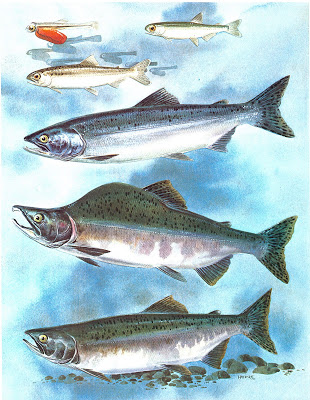Pink Salmon
Oncorhynchus gorbuscha
Pink salmon are also known as humpy salmon.
Description: Pink are the smallest of the five eastern Pacific Ocean salmon species. Pink can reach up to 24 inches and usually weigh between 3 to 5 pounds. While at sea, pink are silvery on the sides and have blue backs with large, oval-shaped spots on their backs and across their tails. A male pink salmon develops a prominent dorsal hump and for both sexes, the ventral silvery color is replaced with pale pink coloration with olive-brown to whitish blotches below the lateral line.
In Whatcom County: During odd years, e.g., 2017, 2019, spawning pinks will be present in all three forks of the Nooksack River, as well in their tributary streams. Currently, the pink population in the Nooksack River Basin is considered to be healthy. Locally, there is no hatchery program for pink.
Range: In North America, from coastal Washington and Puget Sound northward to Alaska’s Yukon River. In Asia from Hokaido Island, Japan northward along the coast, Sakhalin Island and Kamchatka Peninsula to the Lena River on the East Siberian Sea.
Life History: Pink are known for their precise two year life cycle (all spawn at age two). Within a few weeks after emerging from the gravel, fry move quickly to the estuary and nearshore before migrating to the open ocean. In Puget Sound, almost all pinks arrive on odd years (the adults arriving in 2017 are the progeny of the 2015 run). Farther north, pink have both even and odd year runs in the two year life cycle
Spawning Season: July through mid-September.
Habitat Requirements: The same as for other species by requiring clean, cool well oxygenated water in streams with suitable spawning habitat. Similar to chum and certain Chinook juveniles, pink juveniles migrate to the estuary and nearshore as fry and thus are not dependent on a lengthy period in fresh water compared to those Chinook juveniles out migrating as parr or yearlings and to coho, sockeye and steelhead rearing in freshwater for a year or more before out migrating.
Did You Know? Of the five local salmon species, only pink juveniles lack parr marks (dark vertical bands along the body). Among Pacific salmon, pinks are the most likely to stray and not home to the natal stream. Attempts to establish an even year run of pink salmon in Puget Sound were not successful. However, even year runs occur not that much farther north in British Columbia where odd year runs also occur. Also in Alaska, rivers have both even and odd year runs with one usually predominating. Similar to chum salmon, pink salmon flesh is pale and not red as in sockeye, Chinook, coho and steelhead. It also lacks the fat content of the latter four. Consequently, it is not marketed very much as fresh salmon, but more likely canned or made into salmon burgers and frozen.
Photo credit: Pacific Salmon- Childerhose and Trim - Douglas & McIntyre Vancouver/Toronto


